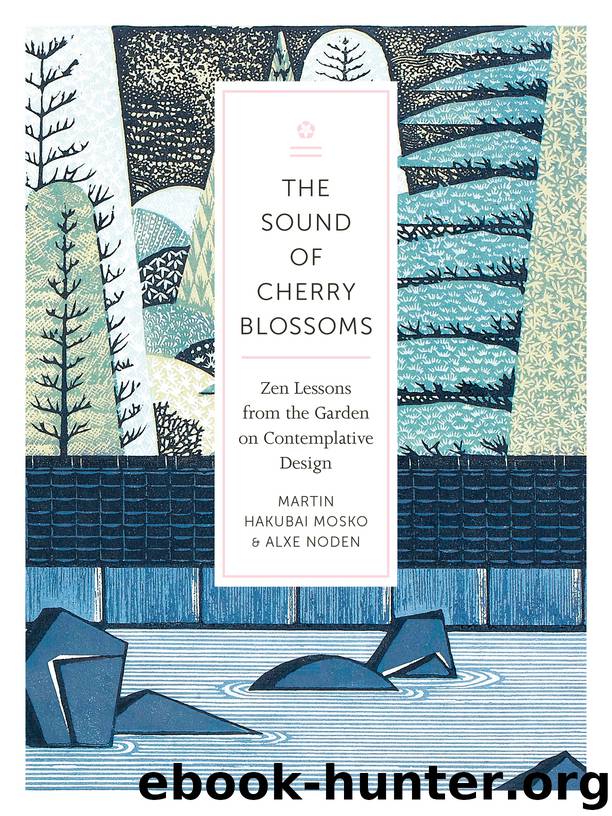The Sound of Cherry Blossoms by Martin Hakubai Mosko

Author:Martin Hakubai Mosko
Language: eng
Format: epub
Publisher: Shambhala
Published: 2018-03-20T04:00:00+00:00
EVALUATE THE DESIGN AND ADAPT IT TO THE VISION
Once the vision of the design manifests as a working document, everyone can see it, examine it, imagine it, and evaluate it. The View is the common language of evaluation. It gives us the way to talk about the merit of the contemplative garden. Does it enrich our senses and our ability to wonder? Does it magnetize our awareness through its compelling beauty? Does it destroy our story line, our sense of self and isolation? Is there a proper balance of Heaven, Earth, and Man? How are the five elements organized and how do they balance? Are all design elements seamlessly integrated making the garden something far greater than its parts? Are intrusive views mitigated? Does the garden satisfy all functional requirements? How does the garden relate to its physical environment? Is it sustainable? How does it fit the cultural and social environment?
Designing a complex garden system, a garden mandala, is a reiterative process, not a linear one. Language forces us to describe the principles and the process in a linear way, but the model is circular and adaptive. The process of design and construction will inform these principles just as the principles inform the design and the construction. Every thought, every action, every external and internal change informs the whole and alters it. The garden is alive, growing and changing, constantly adapting to changes, and so is the process of designing and creating a garden. The garden is not a product but a process.
Step by step we use the View to evaluate the merits and deficiencies of the design. Then we begin the entire process again, using the information gathered from the evaluation to further inform our design process. We begin with meditation, contacting the unborn, limitless realm, and then move to contemplation and visualization. We wait, allowing the reimagined garden image to appear. Once it shows its face, we stabilize it in our mind’s eye and look at it closely. We then draw our vision on paper and refine the model accordingly. At that point, the whole thing is ready for a second evaluation. This process should go on as long as necessary until there is agreement among all parties involved that the design has real merit and should be built accordingly.
It is vital that everyone agree on the final design. Often there are quiet parties who go along with the vision but secretly have misgivings about it. Invariably these objections surface at the most inopportune times and can undermine a project. All parties should be actively involved in the envisioning and evaluation process.
I am a big believer in a slow design process where everything is thought through and everyone is in agreement, followed by a swift and unsurprising construction phase. This may seem costly since so much time is spent on planning with nothing actually happening, but it usually reduces the overall cost. It also gives us time to understand the full implications of the design and, if necessary,
Download
This site does not store any files on its server. We only index and link to content provided by other sites. Please contact the content providers to delete copyright contents if any and email us, we'll remove relevant links or contents immediately.
Kathy Andrews Collection by Kathy Andrews(11323)
The remains of the day by Kazuo Ishiguro(8394)
Paper Towns by Green John(4798)
Spare by Prince Harry The Duke of Sussex(4787)
Industrial Automation from Scratch: A hands-on guide to using sensors, actuators, PLCs, HMIs, and SCADA to automate industrial processes by Olushola Akande(4599)
The Body: A Guide for Occupants by Bill Bryson(4583)
Be in a Treehouse by Pete Nelson(3647)
Machine Learning at Scale with H2O by Gregory Keys | David Whiting(3623)
Harry Potter and the Goblet Of Fire by J.K. Rowling(3608)
Never by Ken Follett(3526)
Goodbye Paradise(3446)
The Remains of the Day by Kazuo Ishiguro(3138)
Into Thin Air by Jon Krakauer(3131)
The Cellar by Natasha Preston(3077)
The Genius of Japanese Carpentry by Azby Brown(3038)
Fairy Tale by Stephen King(2948)
120 Days of Sodom by Marquis de Sade(2939)
Drawing Shortcuts: Developing Quick Drawing Skills Using Today's Technology by Leggitt Jim(2939)
The Man Who Died Twice by Richard Osman(2807)
